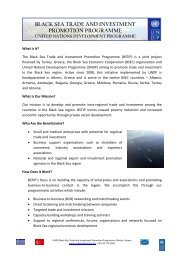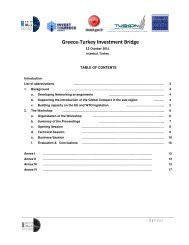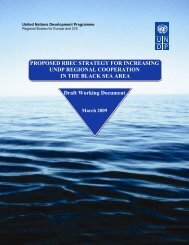Tradeflow Study - UNDP Black Sea Trade and Investment Promotion ...
Tradeflow Study - UNDP Black Sea Trade and Investment Promotion ...
Tradeflow Study - UNDP Black Sea Trade and Investment Promotion ...
Create successful ePaper yourself
Turn your PDF publications into a flip-book with our unique Google optimized e-Paper software.
A more detailed analysis of the indicative intra-regional trade potential can be undertaken<br />
using a trade flow analysis. The trade flow analysis computes the sub-regional exports to the<br />
world <strong>and</strong> imports from the world for each country in the region at the most detailed level of<br />
classification available 7 . Thus for over 5,000 product groups, the indicative trade potential has<br />
been calculated when one country is an exporter of the product group, while another country<br />
is an importer of that same product group. Since the level of disaggregation is relatively high,<br />
the complementarity for trading between partner countries is considered to be relatively high.<br />
Obviously, even at this detailed level, products may not be perfect substitutes, but are<br />
considered to be closely approximate substitutes (see Annex 2.2 for details on the<br />
methodology for trade flow analyses).<br />
The indicative trade potential has been computed for the 5,000 product group <strong>and</strong> ranked<br />
from the highest to the lowest. The twenty five products which display the highest intraregional<br />
trade potential are given in Table 11. The comparison is also made between what is<br />
currently traded between member states of BSEC <strong>and</strong> what the intra-regional trade potential<br />
actually is (indicated as relative indicative trade potential). In the case of motor vehicles<br />
(HS87421) for example, the intra-regional trade potential is calculated as US$2.2 billion.<br />
However, the region only trades around 5% of this amount so that the relative indicative trade<br />
potential is 95%. In the case of Copper, the intra-regional trade potential is calculated as $1.1<br />
billion, which is mainly exported by Russia <strong>and</strong> Bulgaria. The region’s principal importers of<br />
this product group are Turkey <strong>and</strong> Greece (see Annex 2.3 <strong>and</strong> 2.4 for detailed tables of<br />
results for the 300 highest ranking products).<br />
The highest indicative trade potential is primarily in the heavy <strong>and</strong> high technology<br />
manufacturing sectors owing to the large size of trade flows in this area. Russia <strong>and</strong> Turkey<br />
dominate intra-regional export potential while Romania <strong>and</strong> Ukraine primarily dominate intraregional<br />
import potential. However, other smaller countries such as Serbia <strong>and</strong> Montenegro<br />
<strong>and</strong> Bulgaria have a high indicative export potential.<br />
Based on the results of both the gravity equation <strong>and</strong> the trade flow analysis, there appear to<br />
be an enormous untapped intra-regional trade potential which should be the focus of efforts<br />
by trade promotion organisations in the BSEC region.<br />
7 The six digit level of the harmonised system of trade classification has been used<br />
(referred to as HS6). This is the most detailed level possible for cross country comparison<br />
31/135






